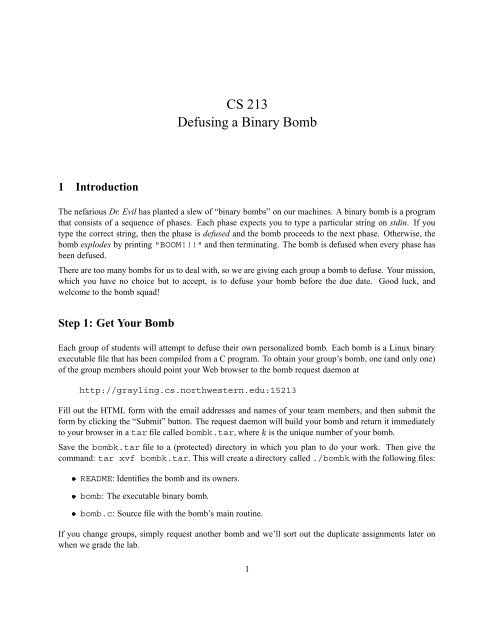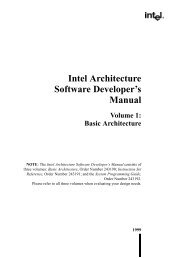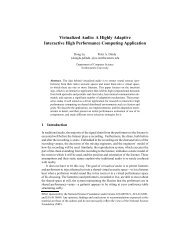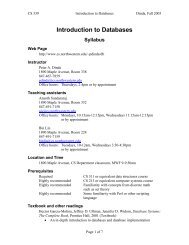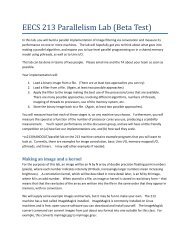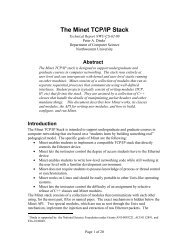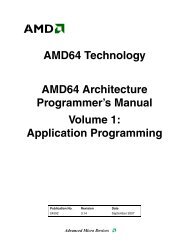You also want an ePaper? Increase the reach of your titles
YUMPU automatically turns print PDFs into web optimized ePapers that Google loves.
¡¡¡<strong>CS</strong> <strong>213</strong><strong>Defusing</strong> a <strong>Binary</strong> <strong>Bomb</strong>1 IntroductionThe nefarious Dr. Evil has planted a slew of “binary bombs” on our machines. A binary bomb is a programthat consists of a sequence of phases. Each phase expects you to type a particular string on stdin. If youtype the correct string, then the phase is defused and the bomb proceeds to the next phase. Otherwise, thebomb explodes by printing "BOOM!!!" and then terminating. The bomb is defused when every phase hasbeen defused.There are too many bombs for us to deal with, so we are giving each group a bomb to defuse. Your mission,which you have no choice but to accept, is to defuse your bomb before the due date. Good luck, andwelcome to the bomb squad!Step 1: Get Your <strong>Bomb</strong>Each group of students will attempt to defuse their own personalized bomb. Each bomb is a Linux binaryexecutable file that has been compiled from a C program. To obtain your group’s bomb, one (and only one)of the group members should point your Web browser to the bomb request daemon athttp://grayling.cs.northwestern.edu:15<strong>213</strong>Fill out the HTML form with the email addresses and names of your team members, and then submit theform by clicking the “Submit” button. The request daemon will build your bomb and return it immediatelyto your browser in a tar file called bombk.tar, where is the unique number of your bomb.Save the bombk.tar file to a (protected) directory in which you plan to do your work. Then give thecommand: tar xvf bombk.tar. This will create a directory called ./bombk with the following files:README: Identifies the bomb and its owners.bomb: The executable binary bomb.bomb.c: Source file with the bomb’s main routine.If you change groups, simply request another bomb and we’ll sort out the duplicate assignments later onwhen we grade the lab.1
Also, if you make any kind of mistake requesting a bomb (such as neglecting to save it or typing the wronggroup members), simply request another bomb.Step 2: Defuse Your <strong>Bomb</strong>Your job is to defuse the bomb.You can use many tools to help you with this; please look at the hints section for some tips and ideas. Thebest way is to use your favorite debugger to step through the disassembled binary.Each time your bomb explodes it notifies the staff, and you lose 1/4 point (up to a max of 10 points) in thefinal score for the lab. So there are consequences to exploding the bomb. You must be careful!Each phase is worth 10 points, for a total of 60 points.The phases get progressively harder to defuse, but the expertise you gain as you move from phase to phaseshould offset this difficulty. However, the last phase will challenge even the best students, so please don’twait until the last minute to start.The bomb ignores blank input lines. If you run your bomb with a command line argument, for example,linux>./bomb psol.txtthen it will read the input lines from psol.txt until it reaches EOF (end of file), and then switch overto stdin. In a moment of weakness, Dr. Evil added this feature so you don’t have to keep retyping thesolutions to phases you have already defused.To avoid accidently detonating the bomb, you will need to learn how to single-step through the assemblycode and how to set breakpoints. You will also need to learn how to inspect both the registers and thememory states. One of the nice side-effects of doing the lab is that you will get very good at using adebugger. This is a crucial skill that will pay big dividends the rest of your career.LogisticsAs usual, you may work in a group of up to 2 people.Any clarifications and revisions to the assignment will be emailed to the class distribution list or posted onthe newsgroups.You should do the assignment on the class machines (tlab-login and tlab-01 through tlab-14). In fact, thereis a rumor that Dr. Evil really is evil, and the bomb will always blow up if run elsewhere. There are severalother tamper-proofing devices built into the bomb as well, or so they say.Hand-InThere is no explicit hand-in. The bomb will notify your instructor automatically after you have successfullydefused it. You can keep track of how you (and the other groups) are doing by looking at2
¡¡¡¡¡http://grayling.cs.northwestern.edu/bombstats.htmlThis web page is updated continuously to show the progress of each group.Hints (Please read this!)There are many ways of defusing your bomb. You can examine it in great detail without ever running theprogram, and figure out exactly what it does. This is a useful technique, but it not always easy to do. Youcan also run it under a debugger, watch what it does step by step, and use this information to defuse it. Thisis probably the fastest way of defusing it.We do make one request, please do not use brute force! You could write a program that will try everypossible key to find the right one. But this is no good for several reasons:You lose 1/4 point (up to a max of 10 points) every time you guess incorrectly and the bomb explodes.Every time you guess wrong, a message is sent to the staff. You could very quickly saturate thenetwork with these messages, and cause the system administrators to revoke your computer access.We haven’t told you how long the strings are, nor have we told you what characters are in them. Evenif you made the (wrong) assumptions that they all are less than 80 characters long and only containletters, then you will ¢¡¤£¦¥ have guesses for each phase. This will take a very long time to run, andyou will not get the answer before the assignment is due.There are many tools which are designed to help you figure out both how programs work, and what is wrongwhen they don’t work. Here is a list of some of the tools you may find useful in analyzing your bomb, andhints on how to use them.gdbThe GNU debugger, this is a command line debugger tool available on virtually every platform. Youcan trace through a program line by line, examine memory and registers, look at both the source codeand assembly code (we are not giving you the source code for most of your bomb), set breakpoints,set memory watch points, and write scripts. Here are some tips for using gdb.– To keep the bomb from blowing up every time you type in a wrong input, you’ll want to learnhow to set breakpoints.– The course web page has a short one page summary of gdb, as well as a link to the online gdbmanual.– For other documentation, type “help” at the gdb command prompt, or type “man gdb”, or“info gdb” at a Unix prompt. Some people also like to run gdb under gdb-mode in emacs.objdump -tThis will print out the bomb’s symbol table. The symbol table includes the names of all functions andglobal variables in the bomb, the names of all the functions the bomb calls, and their addresses. Youmay learn something by looking at the function names!3
¡¡objdump -dUse this to disassemble all of the code in the bomb. You can also just look at individual functions.Reading the assembler code can tell you how the bomb works.Although objdump -d gives you a lot of information, it doesn’t tell you the whole story. Calls tosystem-level functions are displayed in a cryptic form. For example, a call to sscanf might appearas:8048c36: e8 99 fc ff ff call 80488d4 To determine that the call was to sscanf, you would need to disassemble within gdb.stringsThis utility will display the printable strings in your bomb.Looking for a particular tool? How about documentation? Don’t forget, the commands apropos and manare your friends. In particular, man ascii might come in useful. Also, the web may also be a treasuretrove of information. If you get stumped, feel free to ask us for help. Also please be sure to make good useof the course newsgroups, which you can reach from the course web page.4


